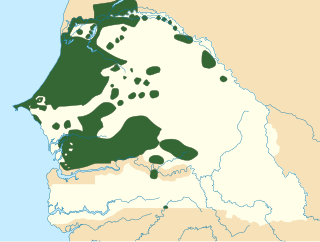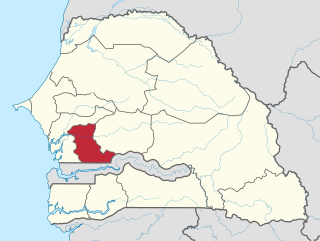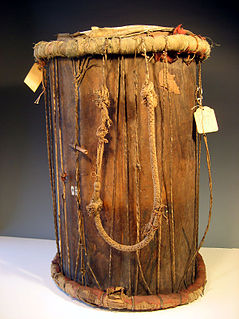
Senegal, officially the Republic of Senegal, is a country in West Africa. Senegal is bordered by Mauritania in the north, Mali to the east, Guinea to the southeast, and Guinea-Bissau to the southwest. Senegal nearly surrounds the Gambia, a country occupying a narrow sliver of land along the banks of the Gambia River, which separates Senegal's southern region of Casamance from the rest of the country. Senegal also shares a maritime border with Cape Verde. The climate is typically Sahelian, though there is a rainy season. Senegal's economic and political capital is Dakar.

Wolof is a language of Senegal, Mauritania, and the Gambia, and the native language of the Wolof people. Like the neighbouring languages Serer and Fula, it belongs to the Senegambian branch of the Niger–Congo language family. Unlike most other languages of the Niger-Congo family, Wolof is not a tonal language.
The Kingdom of Saloum was a Serer/Wolof kingdom in present-day Senegal. Its kings may have been of Mandinka/Kaabu origin. The capital of Saloum was the city of Kahone. It was a sister kingdom of Sine. Their history, geography and culture were intricately linked and it was common to refer to them as the Sine-Saloum.

Biffeche or Bifeche is an area of Senegal centred on the town of Savoigne, around 30 kilometres north-east of the major coastal city of Saint-Louis.

The Serer-Ndut or Ndut also spelt are an ethnic group in Senegal numbering 38600. They are part of the Serer people who collectively make up the third largest ethnic group in Senegal. The Serer-Ndut live mostly in central Senegal in the district of Mont-Roland, northwest of the city of ancient Thiès.

The town and commune of Gandiaye in the Department of Kaolack, central Senegal, lies along National Route 1 about 24 kilometers from Kaolack. The population (2002) is about 10,000 consisting of the Serer, Wolof, Fula, Bambara and Jola) ethnic groups.

The Kaolack region is a region in Senegal. It borders Gambia and is a common stopping point for travel between Dakar and Banjul. Its borders correspond roughly to the Saalum Kingdom of precolonial days, and the area is still spoken of as the Saalum in Wolof, and its inhabitants are called Saalum-Saalum.

Kaolack is a town of 172,305 people on the north bank of the Saloum River and the N1 road in Senegal. It is the capital of the Kaolack Region, which borders The Gambia to the south. Kaolack is an important regional market town and is Senegal's main peanut trading and processing center. As the center of the Ibrahimiyya branch of the Tijaniyyah Sufi order founded by Ibrayima Ñas, it is also a major center of Islamic education. The Leona Niassene mosque (right) in Kaolack is one of the largest and best known in Senegal.

Tivaouane or Tivawan is a city located in the Thiès Region of Senegal.
The Serer people are a West African ethnoreligious group. They are the third-largest ethnic group in Senegal, making up 15% of the Senegalese population. They are also found in northern Gambia and southern Mauritania.
Dodji is a town in north central Senegal. with a 2007 estimated population of 8,281. It is in the Louga Region, Linguère Department, and the Dodji Arrondissement, which consists of the communauté rurales of Dodji, Labgar, and Ouarkhokh. Though a separate administrative unit, Dodji falls under the Commune of Dahra - Linguère. As of 2007, Dodji's highest administrative official, is Math Coueladio Ba, formerly of the Senegalese Socialist Party, now allied to the ruling PDS.

There are various ethnic groups in Senegal, The Wolof according to CIA statistics are the majority ethnic group in Senegal. Many subgroups of those can be further distinguished, based on religion, location and language. According to one 2005 estimate, there are at least twenty distinguishable groups of largely varying size.
Sine-Saloum is a region in Senegal located north of the Gambia and south of the Petite Côte. It encompasses an area of 24,000 square kilometers, about 12% of Senegal, with a population in the 1990s of 1,060,000.
Fatick is a town in Senegal, located between M'bour and Kaolack and inhabited by the Serer people. Its 2005 population was estimated at 24,243. It is the capital of the Fatick Region and the Fatick Department.
The Serer-Noon also called Noon are an ethnic people who occupy western Senegal. They are part of the Serer people though they do not speak the Serer-Sine language natively.

The medieval history of the Serer people of Senegambia is partly characterised by resisting Islamization from perhaps the 11th century during the Almoravid movement, to the 19th century Marabout movement of Senegambia and continuation of the old Serer paternal dynasties.

The Point of Sangomar is a sand spit located on the Atlantic Ocean at the mouth of the Saloum Delta, which marks the end of the Petite Côte west of Senegal.

Ziguinchor is the capital of the Ziguinchor Region, and the chief town of the Casamance area of Senegal, lying at the mouth of the Casamance River. It has a population of over 230,000. It is the seventh largest city of Senegal, but largely separated from the north of the country by The Gambia.
Babacar Sedikh Diouf or Babacar Sédikh Diouf is a Senegalese historian, author, researcher, campaigner against "Wolofization", a Pan-Africanist, and former teacher. He has written extensively about the history and culture of Senegal, Africa, and that of the Serer ethnic group to which he belong. He usually writes by the pen name Babacar Sedikh Diouf.
Wolofization or Wolofisation is a cultural and language shift whereby populations or states adopt Wolof language or culture, such as in the Senegambia region. In Senegal, Wolof is a lingua franca The Wolofization phenomenon has taken over all facets of Senegal and encroaching on Gambian soil. This phenomenon has caused other Senegambian ethnic groups great concern and resulted in taking steps to preserve their languages and culture. In this regard, the Serer ethnic group who have had a long history fighting against Islamization and Wolofization have been taking active steps in the past decades by setting up associations and other organisations in order to preserve their languages, culture and "ancient religious past." Haalpulaar speakers, namely the Fula and Toucouleur have also been taking steps to preserve their language.













